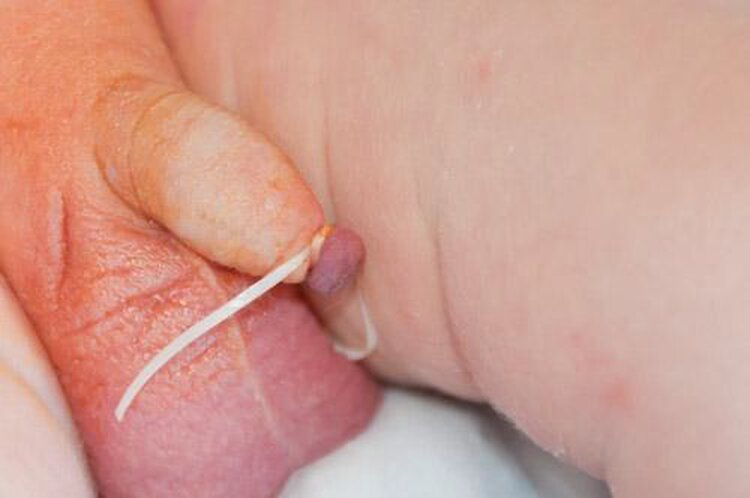Disclaimer: This chapter “Ancient Circumcision” is offered only for information value. It is not offered as medical advice. We strongly recommend that you hire an experienced medical professional for any physical circumcision procedures that might be done in your family. This is simply an explanation of how circumcision was done in ancient times. It is much safer than standard circumcision.
In modern times, medical circumcision removes the entire foreskin. Because an infant’s immune system is so strong right after delivery, children nonetheless heal up relatively quickly. However, this procedure on grown adults and elderly men (such as Avraham) takes a very long time to heal, and is unnecessarily painful.
In contrast to removing the entire foreskin, Yahweh told Avraham only to circumcise himself in his foreskin. This means that the foreskin would remain—only that there would be a circular cut ringing it.
B’reisheet (Genesis) 17:10-14
10 “This is My covenant which you shall keep, between Me and you and your descendants after you: Every male child among you shall be circumcised;
11 and you shall be circumcised in the flesh of your foreskins, and it shall be a sign of the covenant between Me and you.
12 He who is eight days old among you shall be circumcised, every male child in your generations, he who is born in your house or bought with money from any foreigner who is not your descendant.
13 He who is born in your house and he who is bought with your money must be circumcised, and My covenant shall be in your flesh for an everlasting covenant.
14 And the uncircumcised male child, who is not circumcised in the flesh of his foreskin, that person shall be cut off from his people; he has broken My covenant.”
If a 99 year old man makes a cut in his foreskin, he has the ability to heal up in a relatively short amount of time, as opposed to having his entire foreskin removed.
We strongly urge you to have an experienced medical professional conduct any physical circumcision that is performed in your household. However, for information purposes only, the ancient procedure would follow the following steps, were it to be conducted today.
On the 8th day, have on hand:
- Small gauze sponges
- Large gauze sponges
- Sterile absorbent pads
- Sterile latex gloves
- Antiseptic such as providone-iodine (for external use only)
- Healing ointment, such as Eden Salve
- Dental floss
- Sterilized umbilical cord scissors (curved)
- (For adults, have styptic powder, for clotting)
Everything should be sterilized just prior to the medical procedure. Metals such as scissors can be sterilized by boiling them in clean water for five minutes. The trained medical professional and family should pray.
- Lay out everything for easy access
- Make the room nice and warm for the patient
- Having a pair of assistants is a help
- Don sterile gloves
- Remove the patient’s loin covering
- Clean the patient’s groin area with iodine prior to the incision (not after)
- Use dental floss to gently but firmly constrict the blood flow to the patient’s foreskin (acting as a kind of a tourniquet). It should not be super tight, but only snug enough to cause discoloration after a minute or two. The primary function is actually to hold the excess skin forward of the tip of the glans, to ensure a safe and clean cut

8. Line up the scissor blades just outside the floss, double-checking one last time that the tip of the glans will not be cut
9. In prayer, make the cut
10. Immediately after the cut, place a new, sterile absorbent gauze pad over the cut, and gently apply pressure for a minute or two, in order to aid clotting. In an eight-day old child, the blood loss should be minimal, and should stop soon.

11. In a young infant, the bleeding should slow to an ooze after just a minute or two.

12. Within five minutes of the incision, the bleeding should stop altogether, and a healthy clot should be forming.

13. Remove the floss. Place some sterile healing salve on a fresh gauze pad, dress the cut, and cover the loins
For infants, apply a normal post-circumcision process. Apply fresh gauze and petroleum jelly (or similar) with each diaper change. The first few urinations will likely be painful, and the child will likely cry. This is normal. This is far less invasive than a standard circumcision.
Monitor the situation prayerfully. Ensure that the child is urinating normally, and that everything is kept clean. Antibiotics should not be necessary for a healthy eight day old infant. Eighty percent healing is normal within about three days. After three days, begin pushing the foreskin back ever-so-gently with each diaper change, so that the cut skin does not try to grow together, or seal shut. This probably will not happen, but it is a good idea to move the tissues after a few days in any event, once it can be done without re-opening the wound.
This procedure is far less invasive than a normative Western medical circumcision. Notice the minimal amount of foreskin removed, as compared to a penny, and the relatively tiny amount of bleeding.

The commandment in Torah is not to remove the whole foreskin, but to be circumcised in the foreskin. The medical advantages of following the letter of this command should be obvious.
A child’s immune system is strong enough to withstand the full removal of his foreskin. However, an elderly man such as Avraham has an immune system that is nowhere near as strong. While Avraham could easily have survived the above procedure without serious blood loss, or risk of infection, the same cannot be said for the removal of his entire foreskin. This is therefore the kind of physical circumcision that Avraham likely undertook, in fulfillment of Yahweh’s command.






